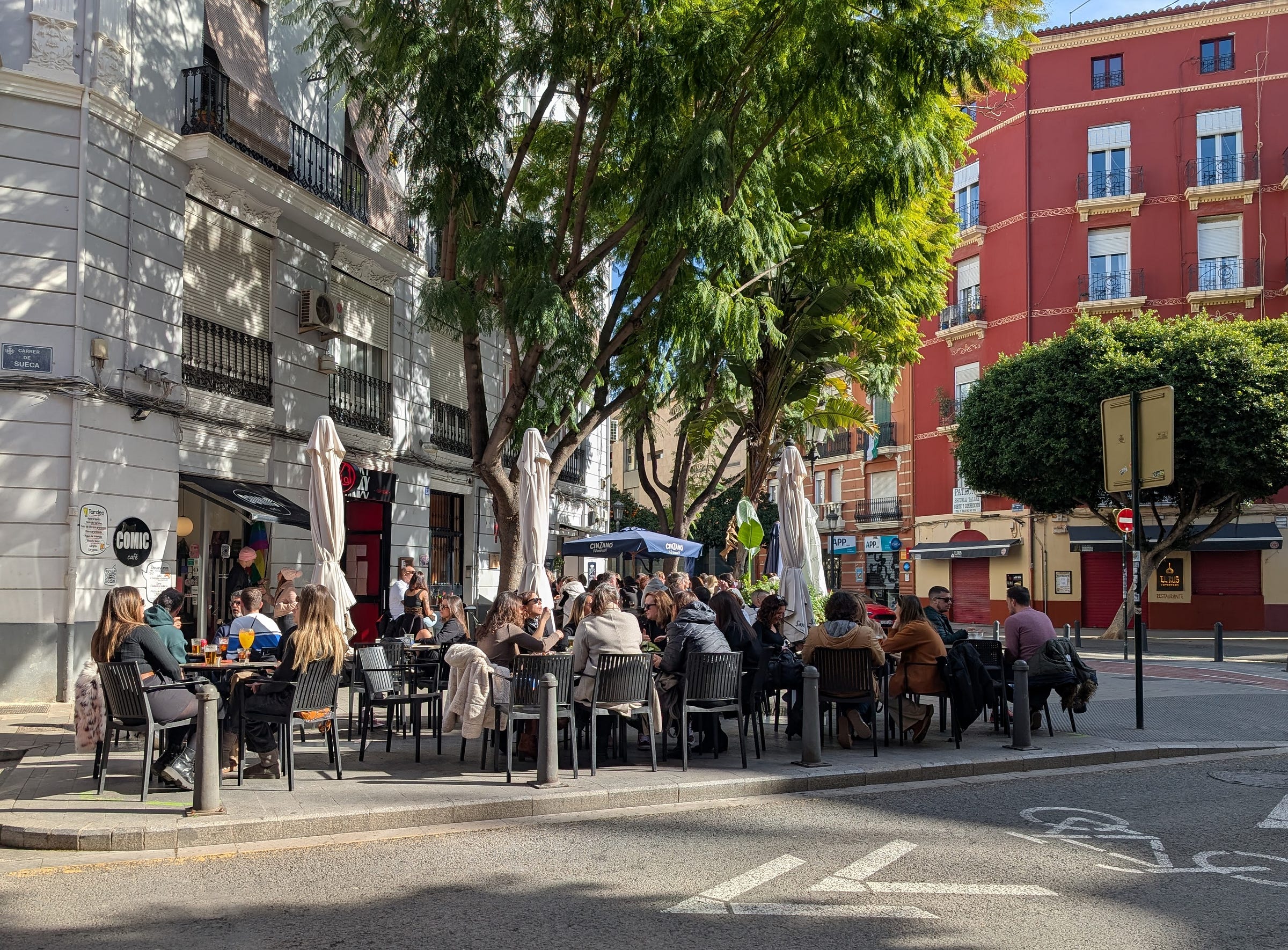Never Retire: The American Hangout Is a Scam
Even in San Francisco, the “affordable neighborhood spot” is a myth. In Spain, it’s just life.
Next week we head back to San Francisco for the first time since moving to Valencia in January.
We’re only going for a couple weeks—mostly for my daughter’s college graduation—but I’m already feeling it: the pull of what we’ve built here, and the quiet calculation of how different everyday spending feels in the U.S.
Four months into life in Spain and it’s already obvious how different things are. Not just because of the language or feeling of safety on the streets—but because daily life is so much more accessible here. The way you move through the city. The way people interact. And yes, the way you just hang out.
Today’s Never Retire newsletter story is about food, drink, and what it costs to sit still for a while—and how that shapes city life.
Solo llevo cuatro meses en Valencia, pero ya voy a echarlo de menos.
I’ve only been here four months, but I’m going to miss it.
Writing for a living helps my Spanish learning. My background—as a former urban studies student and hospitality-driven bartender—helps me see the distinction between quality of life in the U.S. versus Spain.
It’s not even close.
It’s something I’ve obsessed over for years: how hospitality, public space, and affordability intersect. What makes a city feel alive—and what keeps people locked out of that life.
We have a “right to the city,” but in the U.S., you can’t exercise that right in any meaningful way on a regular basis when just sitting at a sidewalk table costs so much money.
In Spain, the sidewalk terrace isn’t some special destination—it’s seamless public space. Part of the city’s rhythm. Everywhere you go, it’s: table, chair, coffee, wine, old guy reading a paper, couple lingering over vermouth. Unremarkable—and that’s the point.
You don’t see this in the U.S.
American cities have more stop signs than sidewalk terraces. Dining out feels like a private act on borrowed space—a transaction, not an invitation.
Last time we went to San Francisco, we got duped into trying a new restaurant that billed itself the way the latest opening of its type does — as “a true neighborhood hangout, where customers can afford to split a bottle and linger throughout the night over a lineup of small plates.”
That quote is from a San Francisco Standard article and refers to a different, newer restaurant — a wine bar in hip Hayes Valley, where well-intentioned neighbors have to fight like hell to get streets closed to traffic. (Here again, this speaks to cultural and sociopolitical differences around who owns and is entitled to urban space that impact hospitality in many ways).
The other restaurant we went to last time was not good and definitely not affordable. The bill ended up coming to what it would come to at any number of equivalent establishments in large, medium, and even some small cities in the United States.
At places like this, three things effectively scam you on price —
They bill small plates as affordable. Maybe they’re not as expensive as the typical large plate, however they add up — fast. The small plate label in America is little more than an opportunistic cash grab. Make no mistake — it’s nothing like tapas culture in Spain.
Alcohol costs a fortune. The article says this about the restaurant in question —
Wines are similarly value-driven, with 13 selections by the glass, most priced between $14 and $16. Focusing on Old World offerings, including a robust roster of white Burgundy, the bottle list offers six in the $50 range and 13 for less.
You pretty much have to leave a tip. I mean who is not going to leave at least 20% after lingering throughout the night over a lineup of small plates?
Do the math and it’s clear that restaurants that say they just want to be affordable neighborhood hangouts are — at best — clueless and tone deaf, or worse, slickly marketing a ripoff.
Two glasses of wine before dinner: $30
Share the aged hanger steak ($18), steak carpaccio with Italian butter beans ($17) and Catalan-style — (por favor!) — pork and trippa ($16): $51.
Of course, you’ll need two more glasses of wine (who doesn’t?): $30
$111 plus 20% tip — $133.22
It’s funny that the Standard — which I generally love — says, “Notably, everything on the menu comes in under $20.” As if, sub-$20 prices have become the new threshold for affordability?
Tell that to the person living across the street trying to make their $2,500 rent payment every month, then pay $6 for a dozen of eggs.
Across Spain, you can sit on a terrace and drink a beer or glass of wine for just under, just over, or exactly 3€. You can get small plates — tapas, priced like small plates pretend to be in the U.S. for between the prices of a beer or glass and wine and, typically, on the higher end, 12€ to 15€.
This is at the many neighborhood joints that line street after street in city after city and town after town in this country. You can go and hang out — no quotes necessary — at actual hangouts. And you and I and people with more or less money than us do it every single day — from early in the morning to late at night — side by side.
Because hospitality here is truly egalitarian and affordable.
I’m not saying the United States can — or even should — be like Spain. It’s likely not possible, for a whole host of economic, political, and cultural reasons. But I am saying: stop calling a place — or acting like it’s — an affordable hangout when it’s anything but.
That’s not the culture — so don’t dress it up and sell it to people who just want to sit, talk, and be part of city life without paying a premium for it. It’s a carefully disguised cash grab posing as affordable public life — and it couldn’t be further from what you see in Spain.
Now, some quick Spanish practice—(here’s how I do it)—
The other restaurant we went to last time was not good and definitely not affordable. The bill ended up coming to what it would come to at any number of equivalent establishments in large, medium, and even some small cities in the United States.
At places like this, three things effectively scam you on price —
El otro restaurante que fuimos la ultima vez no era bueno y no barato, definitivo. La cuenta cuesta parecida que pudiera a varios restaurantes similares en grande, mediana y incluso algunas ciudades pequeñas en Estados Unidos.
En lugares así, tres cosas te estafo en precio—
The mistakes—a few things I learned previously that have yet to fully stick and a couple new ones.






My best friend moved to Italy almost 40 years ago. Her visits here to Brooklyn are always a treat but also enlightening. She has the distance to see American life from the outside. Pharmaceutical Ads were a big shock, but she also comments on the constant commercial vibes. Everything is a push to buy something.
Free market capitalsim is our religion. Looking out and caring for one another is fading into the background. Looking forward to experiencing the Spanish life you describe so well.
Just as a (rough) comparison:
Last night, my wife and I went to a local pizza place. One 16” pizza, 1 drink, and 2 beer were just over $45, before tip. The food and service are consistently great, and it’s finally nice enough here to sit outside… except that means sitting next to a 4 lane thoroughfare.